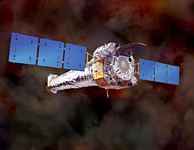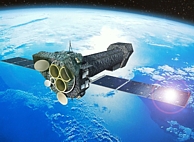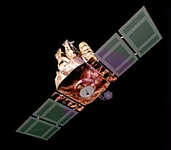Chandra Space Telescope
 The Chandra X-ray telescope is a device specialized in astronomical observations in the X-ray range, launched into orbit in 1999 as a NASA project. This telescope seeks to specifically study the X-ray emissions of celestial objects, a range that is also mostly absorbed by the Earth's atmosphere, making a telescope of these characteristics necessary for its study, orbiting the Earth outside of atmospheric influence. It is especially useful for studying exotic objects and violent processes of stellar evolution, which are often accompanied by large X-ray flares.
The Chandra X-ray telescope is a device specialized in astronomical observations in the X-ray range, launched into orbit in 1999 as a NASA project. This telescope seeks to specifically study the X-ray emissions of celestial objects, a range that is also mostly absorbed by the Earth's atmosphere, making a telescope of these characteristics necessary for its study, orbiting the Earth outside of atmospheric influence. It is especially useful for studying exotic objects and violent processes of stellar evolution, which are often accompanied by large X-ray flares.
XMM-Newton Observatory
 The XMM-Newton (X-Ray Multi-mirror Mission-Newton) is an X-ray observatory, launched into space with the aim of showing regions of the Universe in this sector of the electromagnetic spectrum. It consists of 3 X-ray telescopes made up of concentric mirrors, as well as an optical monitor that allows observing X-ray objects in the UV and visible range. XMM-Newton specializes in detecting some of the most energetic and violent events that happen in the Universe, which is why its main findings are supernova explosions, active galactic nuclei or neutron star activity. It has discovered countless previously unknown sources of X-rays.
The XMM-Newton (X-Ray Multi-mirror Mission-Newton) is an X-ray observatory, launched into space with the aim of showing regions of the Universe in this sector of the electromagnetic spectrum. It consists of 3 X-ray telescopes made up of concentric mirrors, as well as an optical monitor that allows observing X-ray objects in the UV and visible range. XMM-Newton specializes in detecting some of the most energetic and violent events that happen in the Universe, which is why its main findings are supernova explosions, active galactic nuclei or neutron star activity. It has discovered countless previously unknown sources of X-rays.
Solar and Heliospheric Observatory
 This space observatory (SOlar and Heliospheric Observatory [SOHO], for its acronym in English), is a device specialized in astronomical observations of our Sun, launched into orbit in 1995 as a joint project of NASA and ESA. SOHO has provided important data in the understanding of the Sun, its use being particularly important in predicting solar flares or the flow of the solar wind. Monitoring solar activity reveals data about the behavior of our star, such as the flow of sunspots and the temperatures in its different layers. A curious aspect of SOHO is that it has discovered by itself more than 1,000 comets close to the Sun, impossible to see from Earth due to the strong luminosity of our star.
This space observatory (SOlar and Heliospheric Observatory [SOHO], for its acronym in English), is a device specialized in astronomical observations of our Sun, launched into orbit in 1995 as a joint project of NASA and ESA. SOHO has provided important data in the understanding of the Sun, its use being particularly important in predicting solar flares or the flow of the solar wind. Monitoring solar activity reveals data about the behavior of our star, such as the flow of sunspots and the temperatures in its different layers. A curious aspect of SOHO is that it has discovered by itself more than 1,000 comets close to the Sun, impossible to see from Earth due to the strong luminosity of our star.

